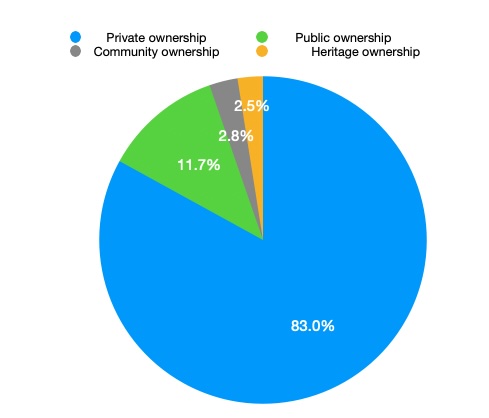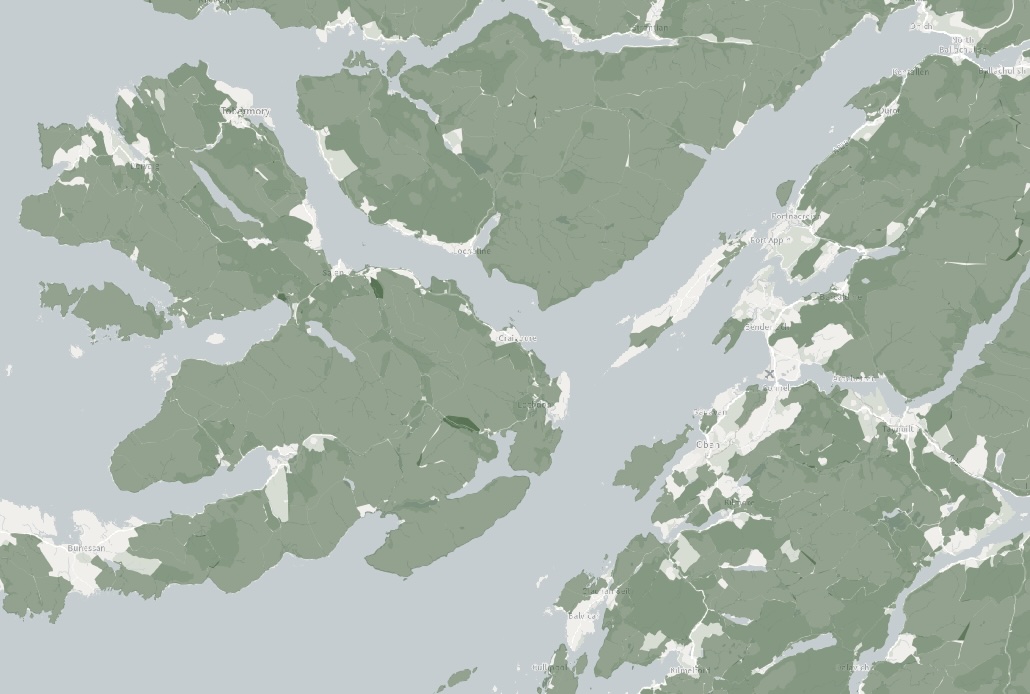Who Owns Scotland 2024 (a preliminary analysis)
It is twelve years since I last published comprehensive statistics on who owns Scotland. With a Land Reform Bill going through Parliament, I though it might be helpful to bring the data up to date. There are obvious connections between this data and the Land Reform bill and I will be publishing a separate analysis of this in the next few days.
I run the Who Owns Scotland project which aims to document the ownership of 75% of Scotland and is on track to achieve this by May 2025. Data derived from this project and other sources has formed the basis of what is a preliminary analysis of who owns Scotland 2024. I will be publishing a fuller and final analysis later this year.
You can read my report Who Owns Scotland 2024 here.
The Guardian has a story about it today.
In summary, here is what I found.
Rural Scotland is still overwhelmingly privately-owned accounting for 83% of rural Scotland. For the purposes of this study, private ownership excludes public, heritage and community landowners.

Community landownership has increased by 40,048 ha from 172,294 ha in 2012 to 212,342 ha in 2024 (a 23% increase in extent) and accounts for 2.8%
Environmental organisations such as the National Trust for Scotland and the Royal Society for the Protection of Birds own much what they did 12 years ago at 2.5%.
The public sector estate has decreased by 20,907 ha (2.2%) since 2012 and now owns 11.7% of rural Scotland.
Private rural landownership has become more concentrated over the past 12 years with 433 landowners owning 50% of the privately-owned rural land in 2024 compared to 440 in 2012 (see table below).
| % of private rural land held | No. owners 2012 | No. owners 2024 | extent (ha) 2024 |
| 10% | 16 | 16 | 639,268 |
| 20% | 50 | 51 | 1,278,535 |
| 30% | 111 | 115 | 1,917,803 |
| 40% | 224 | 225 | 2,557,071 |
| 50% | 440 | 433 | 3,196,339 |
| 60% | 989 | 968 | 3,835,606 |
| 70% | 3,161 | 2,877 | 4,474,874 |
Whereas in 2012, 3380 landowners owned 4.5 million ha of privately-owned rural land, now that same amount is owned by 3012 owners.
Landholdings are getting larger. Today, 1238 landowners own 3,993,022 ha of land (62.5% of privately-owned rural land) in landholdings of over 500 ha in extent compared to 1252 in 2012 who owned 3,992,194 ha (62.4%).
What is going on?
Well, as far as the very largest landowners are concerned (those who account for half of the privately owned rural land) some have sold and their land has been bought by others. That is normal. But big players like the Duke of Buccleuch has been selling land, reducing his landholding in Scotland by 32% from 97,890 ha in 2012 to 66,345 ha in 2024.
But such downsizing has been more than offset at the upper end of the landownership scale and at the lower end by the steady accumulation of more land by existing landowners. In my report I highlight examples of those at the top end who have been expanding their holdings. The table below shows the top 20 largest private landowners in 2024.
| Landholding | hectares | Owner | |
| 1 | Glen Feshie & others | 88,296 | Wildland Ltd. (Anders Povlsen) |
| 2 | Buccleuch Estates | 66,345 | Buccleuch Estates Ltd |
| 3 | Gresham House properties | 53,775 | Gresham House Ltd. partnerships |
| 4 | Atholl Estates | 49,853 | Atholl Trustees & Sarah Hope Troughton |
| 5 | Mamore & Killiechonate Estate | 46,764 | Simec Lochaber Hydropower 2 Ltd |
| 6 | Reay Estate | 38,365 | Trustees of the 4th Duke of Westminster |
| 7 | Invercauld Estate | 37,953 | Captain Farquharson’s Trusts |
| 8 | Seafield Estate | 37,901 | Earl of Seafield and Trusts |
| 9 | Strathconon Estate | 36,933 | Strathconon Estates Ltd. |
| 10 | Sutherland Estate | 32,928 | Executors of Countess of Sutherland |
| 11 | Blackmount & Glen Etive Estate | 31,832 | Philip Fleming |
| 12 | Braulen & Glenavon Estate | 28,729 | Andras Ltd. and Glenavon Ltd. |
| 13 | Locheil Estate | 25,684 | Trustees of Donald Cameron |
| 14 | Conaglen & Rothes Estate | 25,541 | Trustees of John and Richard Guthrie |
| 15 | Killilan, Inverinate & Benula | 25,485 | Smech Properties Ltd. |
| 16 | Applecross Estate | 24,877 | Applecross Estate Trust |
| 17 | Drummond Estate | 24,665 | Baroness Willoughby de Eresby |
| 18 | Various properties | 24,258 | Julia & Guy Hands |
| 19 | Corrour Estate | 23,037 | The Corrour Property Company |
| 20 | Corrievarkie Estate | 22,738 | Compania Financiera Waterville SA |
- Wildland Ltd (Anders Povlsen) has expanded its landholdings by 37% from 64,457 ha in
2012 to 88,296 ha in 2024. - Gresham House Ltd. owned no land in Scotland in 2012 and now owns more than
53,775 ha of land via a number of Scottish Limited Partnerships and other vehicles
making it the third largest private landowner in Scotland. - Strathconon Estates Ltd. has expanded its landholdings by 31% from 28,266 ha in 2012
to 36,933 ha in 2024 through the acquisition of Scardroy Estate in 2013 and Ledgowan.
Estate in 2017. - Julia and Guy Hands owned 7113 ha in 2012 and have expanded their landholding by
241% to 24,258 ha in 2024. This includes the 5632 ha Griffin Estate in Perthshire on the
market in 2023 at offers over £130 million.
Other owners, mainly London-based financial corporations have been expanding their landholdings. Some of these are highlighted in my Rural Land Market Report 2020 – 2022.
Legal entities (companies, trusts and partnerships own more that 65% of all privately-owned rural land with around 35% owned by individuals.
Understanding who owns Scotland, how the pattern is changing and why is a vital part of designing policies and legislation to change that pattern. The current trend is being driven by powerful financial interests and there are no meaningful measures being proposed to reverse it.
I will be publishing further blogs on some of the stories behind the statistics in the coming weeks.
Please read the full report here.

Thanks for all the info. most interesting. Did you know that Loch Rosque and West Fannich has been sold or at least all the hill ground.
the Wilson Family have sold them
I have checked and yes, part was sold in July 2023. I only update records once a year so was not due to look at this until May – so thank you. I have ordered the deed to see how much has been sold.
great work Mr Wightman, thank you for your efforts
Thanks for your kind comment. This work is still rather time-consuming but it is getting a bit easier thanks to digital technology.
Well done Andy, great information 👍
Thanks, Lyle.
Thanks once again Andy for such a valuable resource (no pun intended). It is is helpful to know exactly who owns our land and it will be even more essential when we achieve our goals.
Great stuff; could be basis for useful work by others I hope? Land use e.g. afforestation/type ; grouse moor; deer/stocking destiny; hill sheep/tenancy; riparian management. You would know better than me! Would like to think you had instituted a perpetually updating data base. Smile.
It absolutely is the basis of work for others! See this review of land ownership data in Scotland, for example: https://zenodo.org/records/10727568. There will also be a report coming out of SRUC soon that has mapping of land use and also financial flows to owners.
Great work Andy! Are you recording how much of the land is owned using Scottish Limited Partnerships, or other dodgy vehicles?
I’m wondering what would happen if Scottish Limited Partnerships were banned, and retrospective action was employed to dismantle those in existence.
I am steadily (and retrospectively) logging the legal entity behind every landholding including SLPs
Fantastic Work, Andy. Very illuminating. I wish we had a similar assessment for my state, Louisiana. Rural landholdings here may be just as, and in some areas, even more highly concentrated here.
Thanks. Montana has a very detailed cadastral register – perhaps one of the best in the USA? https://svc.mt.gov/msl/mtcadastral
Thanks for all the information. I know on a local level the understanding of land ownership is a minefield.
Buildings crumbling in town centres, planning issues created by absentee owners, an alarming number of gaps in the registry and councils-farmers etc being hit by huge bills off previously invisible owners claiming their land rights have been violated.
We need continuous investigation and probably far more reaching, aggressive land reform than is currently being proposed.
Circling back to crumbling buildings, many attempts are made to try and get the owners, big, faceless foreign entities to take accountability. They never do. And we end up footing the bill for demolition too.
Its been an exhausting part of my local politics experiences.
So thank you for the work and investigation. On everything I have seen, its needed.
Thank you for all your hard work Andy.
It it very interesting and depressing.
We need to do something about it, which is what you are doing.
Informing those who care about something so unfair.
Hi Andy,
Jim Clark from Dundee here. I wondered if you required any assisstance in your efforts.
I’m retired and happy to help if you could use any assistance. Keep up the good work,
Thanks – I will let you know if I do…
The new lunacy is ‘rewilding’ for carbon credits. Invite the great Dane to try rewilding in Denmark. Unlikely to happen other than in a zoo. While land purchase here is possible for a foreign national, it is unlikely that a Brit or Scot could do the same in Denmark.
Your meticulous attention to the property market’s ins and outs always impresses.
Here we fight on to save our green belt at Woodhall, Faskine and Palacecraig from predatory developers supported by the absentee land owners, Whitelaw daughters. One accupies an estate near Peebles and has an interest in Dawyck, thereby being a trustee of the Royal Botanic Gardens in Edinburgh. Meanwhile the walled garden at Woodhall crumbles through prolonged neglect. The planning application for 3,200 houses comes before the full North Lanarkshire Council shortly.
Nice to hear from you Ann. Hope all is well.
Hi Andy,
Very illuminating. Especially if one relates your findings and commentators wishes for this alarming trend to stop – in relation to Graeme McCormick “AGFRR” New Public Funding For an Enterprising Scotland (September 2020).
Scotland and her people have so much potential……
Regards,
Marion Richardson
How much of the land in Scotland is defined as or considered rural?
I think the official figure is 98% rural, 2% urban.